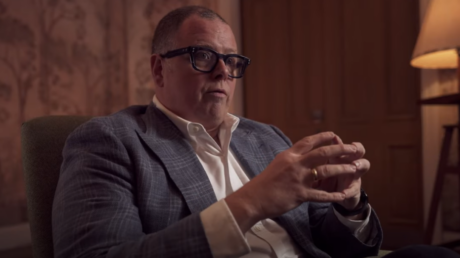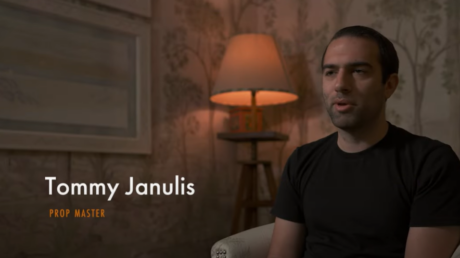With the Apple TV+ series now in its third and final season, costume designer Ernesto Martinez discusses the evolution of the main cast’s wardrobes and working with Rose Byrne: “We would literally get into the psychology of a skirt.”
The 1980s are nearly synonymous with bad hair and even worse fashion, and that’s exactly the association Ernesto Martinez didn’t want audiences to have with the clothing on Physical when he began crafting the wardrobe for the Apple TV+ series.
“I didn’t want Physical to look like a show that was in the ‘70s and ‘80s, even though it has fashion from the ‘70s and ‘80s,” Martinez tells The Hollywood Reporter. “I really wanted to make sure that when you see Physical five years from now, it doesn’t look silly.”
Now in its third and final season, Physical stars Rose Byrne as Sheila Rubin, a 1980s housewife battling a host of inner demons who, oddly, finds her peace and her passion through aerobics. Since its debut in 2021, viewers have watched Rubin’s past traumas — and present archnemesis Kelly Kilmartin, played by Zooey Deschanel — threaten to ruin her success on her quest to simply be somebody, as a woman with dreams far bigger than her surroundings in San Diego. And with each new season, Martinez has made sure Rubin’s clothing, and that of the women around her, reflects their journey to becoming their true selves — big hair, bright colors and all.
“I didn’t want it to look kitschy,” Martinez says of channeling ‘80s icons like Ivana Trump and Jane Fonda through the show’s costumes. “I wanted Physical to feel timeless.”
Coming into the final season of Physical, what was your focus as you closed out the story on these characters from a clothing perspective?
I really wanted to show how they grew from season one to three. There’s such a huge difference in the characters and where they were in their lives — with their success in business, their love lives; everything about them changed. Greta’s [Dierdre Friel] character went from being a really insecure person in a misogynistic relationship to a very evolved, bra-burning type of woman who’s successful and making her own money. She was the epitome of a kept woman, and she really changed her narrative by the end of Physical. Sheila changed Greta and everything about her and their whole small life in San Diego and I wanted the clothes to reflect that.
I had Sheila in very bold colors, but also kind of “designery” for San Diego. I always wanted her to look like she was from somewhere else. She never thought of herself as being from San Diego. She was always living way beyond her means, even when she wasn’t successful by season three, and I wanted to incorporate the competitive part of her with Kelly Kilmartin. I had to bring that in, and the costumes reflected that — strong colors, ‘80s shoulders, over-the-top jewelry. It was all very Ivana Trump. We channeled a lot of Jane Fonda, too. I didn’t want it to look kitschy.

In this world of aerobics and accompanying body issues, Greta is sort of the antithesis of the ‘80s “thin is in” aesthetic. What was most important when it came to shaping her image?
In the beginning of the first season, I felt the creators intentionally didn’t want her to look pretty. And then by the end of that season, she was having an epiphany of some kind. So, when we opened up in season two, I really started to push the envelope and give her clothes that were a little bit more fitted, a little bit more colorful. I was showing that she was a little bit less afraid of the body she owned, and pushing into acceptance of who she is and channeling her desire to be more like Sheila. Because ultimately that’s what she was doing.
In season two, her narrative really started to change. And then by season three, where we’re at, she’s full-on embraced who she is. Greta really is a very smart woman and she’s a very integral part of Sheila and the business, and she’s not going to take any more crap from anyone. And I really tried to show that through her wardrobe choices. She’s wearing bold prints, primary colors and very fitted clothing.
Did you use any specific designers or partner with any brands on the wardrobe?
I made a lot of the wardrobe, and I copied a lot. I say copied because I literally copied right off the rack. I copied a lot of Christian Dior, a lot of Halston. I took a lot of Saint Laurent from back in the early ‘80s and redid them. We did a lot of St. John. That pink silk dress that Sheila wears in episode five, that’s vintage St. John that I got from their archives. The bags were really great too. We got a lot from Judith Leiber and Gucci. A lot of the shoes were from Maud Frizon, Charles Jourdan, and Susan Bennis/Warren Edwards. Those were really great designer shoes back in the ‘80s.
What were some of the challenges with bringing this wardrobe to life?
One of the challenging looks was the dance number we did with Kelly Kilmartin. I had to find a dress that would do all the things they wanted to do and make it sexy. Edie Adams did a very popular ad for Muriel Cigars in the ‘60s and I was channeling that sort of look and vibe. All the spandex looks were challenging all the time. They had to be kind of coordinated and choreographed at the same time. We made them all, like, overnight. Sourcing all of those dresses and suits and fabrics was pretty challenging as well. You’d be surprised at how very little of the ‘80s is around. You’ll find the kitschy stuff, but you won’t find the good stuff. The really nice things that are classic and don’t look like Wham!
Why do you think that is?
I think that people associate those years with bad fashion. I didn’t want Physical to look like a show that was in the ‘70s and ‘80s, even though it has fashion from the ‘70s and ‘80s. I really wanted to make sure that when you see Physical five years from now, it doesn’t look silly. There’s a lot of shows, like The Goldbergs, that I find to look silly and not timeless. I wanted Physical to feel timeless.
What was your approach when it came to dressing the male characters? Were there any short shorts fights?
There was that, but quite honestly, Physical is really about women. It’s a women’s show. Sheila Rubin is the focal point, and her husband and the male characters were very secondary so I kind of froze them in time. With Danny [Rory Scovel], I kept him the same as in the show opening. I didn’t change his fashion too much because he never evolved. The writing, I felt, was more involved with the women and how they were changing, and how the men were stuck and that’s what I tried to convey in their wardrobe as well. They didn’t have any involvement in their wardrobe and that was kind of intentional. I didn’t want them to look any different in 1979 than they did in 1983 because in the scripts, they don’t change. They’re still kind of fucked up in the way they look at women, and the way they treat women and being controlling with money and trying to use them.
Rose Byrne, on the other hand, was very involved with her wardrobe, right?
She’s a lovely collaborator. We wanted the wardrobe to kind of be a focal point and she wanted to look a certain way for certain scenes, and we would collaborate on that, and what colors we would use and what colors to stay away from for each person. I didn’t use yellow at all on anyone because Kelly was in yellow all the time. She was a great one to dress as well. Zooey Deschanel is fantastic. I made all of her clothes. But collaborating with Rose was really great because we would have six or seven things that we’d try on and then we’d put the wig on, and we’d talk about it. I’d say, “Well, are you going to be comfortable wearing this for that long of a scene? Is it the right tone? Is it the message that you want to send?” We would literally get into the psychology of a skirt.
Hair, as you mentioned, is such a big part of this time period and the show as well. What was it like collaborating with the hair department?
It was great. Audrey Futterman-Stern was fantastic. She made Sheila’s wigs — she did the hair for all the women — but that wig was like a show on its own. The transformation that would happen when Rose would put that wig on was just incredible. You really had to see it to appreciate it. When you see that wig in person, it’s like 10 feet tall. It’s like a big wedding cake on your head. But Audrey did such a great job and so did the makeup team. They made it really stylish and kind of sexy and in charge. When you have that kind of hair it really does something to you.
When it comes to awards for wardrobe design, historic period pieces tend to receive a lot of accolades. Yet, in a way, series like this are period pieces in their own right. Are you hoping to see costuming gain more recognition for work like this in the future?
I really shy away from a lot of recognition and all of that. My joy and my ultimate feeling of success is being able to do the job, being invited to do the work and doing the work and the challenge of the work. It’s really satisfying. Emmys and all of that doesn’t really do a lot for me. I’ve already won the Emmy by having the job. I kid you not. I’ve done a lot of work and with every show I’ve done, I’ve always felt like: I can’t believe they’re paying me to do this. And that’s the truth.
Interview edited for length and clarity.
Physical releases new episodes Wednesdays on Apple TV+.
This story was originally published on The Hollywood Reporter on August 31, 2023 and was written by Brande Victorian.




